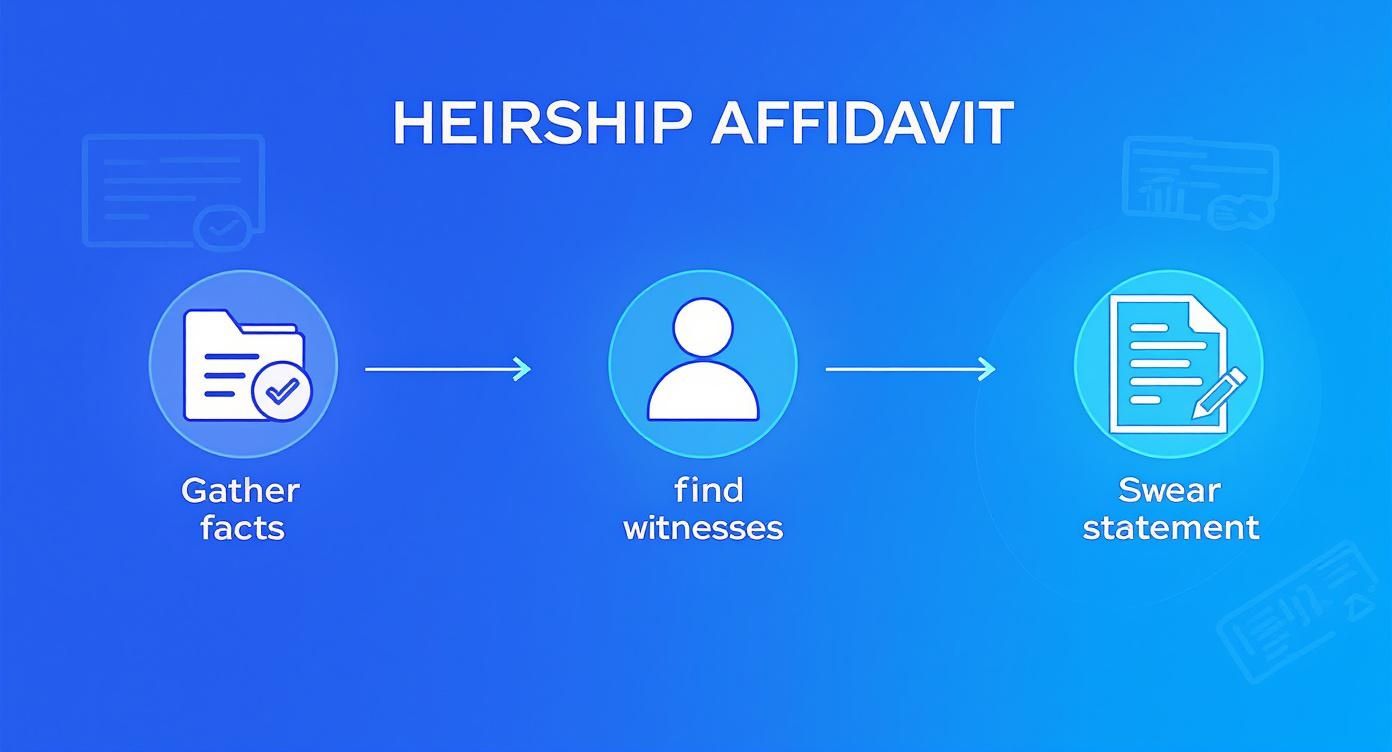When a loved one passes away without a will, their property doesn’t just automatically transfer to the family. We understand that this enters a legal limbo that can feel confusing and stressful, especially when you're grieving. In Texas, an Affidavit of Heirship offers a practical and often faster alternative to formal court proceedings, particularly when the main asset left behind is the family home.
It’s a sworn legal document that formally identifies the deceased person's rightful heirs, clearing the path to transfer property with clarity and peace of mind.
Understanding the Texas Affidavit of Heirship

Losing a family member is hard enough without the added burden of a complex legal mess. For many Texas families, the idea of going to probate court is intimidating. An Affidavit of Heirship can provide a simpler path forward, but it only works in specific situations.
Think of it as a formal, written family history that gets recorded in the public land records. In simple terms, it's a way to establish a clean chain of title for real estate without needing a judge's approval. This document essentially tells the world, "This person passed away without a will, and here are the people who, by law, are their heirs."
When Is an Affidavit of Heirship a Good Option?
This legal tool is most effective when the deceased person (known as the "decedent") left no will and their estate consists mostly of real estate. It's a way to sidestep the time and expense of a full probate administration.
When someone dies without a will—a situation called dying "intestate"—the Texas Estates Code dictates how their property is divided among relatives. An affidavit helps make that transition official. It's typically used when:
- No Will Exists: The decedent passed away without a valid Last Will and Testament.
- Real Estate Is the Main Asset: The primary goal is to transfer the title of a house or land.
- All Heirs Agree: Every legal heir is on the same page about how the property should be handled and is willing to cooperate.
- No Outstanding Debts: The estate has few or no debts, or any existing debts are tied to the real estate itself (like a mortgage).
Key Insight: An Affidavit of Heirship is not a court order. It's a sworn statement of facts about the decedent's family history. Once it's filed in the county records, it creates a legal presumption of heirship that title companies and other third parties can rely on, allowing families to move forward.
The Legal Framework Behind the Affidavit
To really grasp how an affidavit of heirship works, it helps to know the fundamental principles of property law that control how assets are transferred. This affidavit acts as a bridge, connecting the decedent's ownership to the heirs' new ownership based on the intestate succession laws found in Title 2 of the Texas Estates Code.
This process often provides a more compassionate alternative to formal court, allowing your family to focus on healing rather than navigating a complicated legal system. It is just one of several tools, including Wills & Trusts, that families can use to manage an estate.
Meeting the Legal Requirements for an Heirship Affidavit
For an Affidavit of Heirship to be a valid tool in Texas, it must meet specific legal standards outlined in the Estates Code. It’s not just another form to fill out. Instead, see it as a formal, sworn statement that becomes part of the public record. Its power and reliability hinge entirely on its accuracy.
The document must paint a complete and truthful picture of the deceased person’s family history—marriages, children, and other relatives. If it doesn’t, title companies, courts, and banks are likely to reject it. Even a small error or omission can create significant roadblocks down the line.
The Role of Disinterested Witnesses
The single most critical piece of a Texas affidavit of heirship is the testimony of two disinterested witnesses. This isn't just a suggestion; it's a non-negotiable requirement that serves as the bedrock of the affidavit's credibility.
So, what exactly is a "disinterested witness"? It’s someone who ticks two very important boxes:
- They knew the deceased person personally and can speak to their family history (who they married, how many kids they had, etc.).
- They will not inherit any property or receive any financial benefit from the deceased person's estate.
That second point is crucial. A child, grandchild, spouse, or any other potential heir simply cannot act as a disinterested witness. Why? Because they have a financial stake in the outcome. The law demands neutral third parties—think of a long-time friend, a trusted neighbor, or a colleague. Their impartiality is what makes the information trustworthy. To dig deeper, check out our guide on proofs in Texas probate affidavits.
Essential Information to Include
The affidavit must be a thorough document, sworn to by both the heir(s) and the two witnesses. To satisfy the Texas Estates Code, Section 203.002, it absolutely must include the following details:
- Decedent’s Information: Their full legal name, last known address, and the date and place they passed away.
- Marital History: A complete timeline of all marriages. You'll need the spouse's name, when the marriage started, and how it ended (whether by death or divorce).
- Family Tree: A comprehensive list of all children, both biological and adopted. For every child, you need their name, birth date, the name of their other parent, and whether they are still living.
- Heir Identification: A clear statement spelling out who the legal heirs are according to Texas's intestate succession laws.
- Estate Debts: A declaration confirming that all of the estate’s known debts have been paid.
- Property Description: The full legal description of the real estate that's being transferred.
A Real-World Example: Let's talk about Maria. Her father passed away without a will, and he’d been married twice. To complete the affidavit, Maria had to list not only his marriage to her mother (which ended when he died) but also his first marriage from decades ago that ended in divorce. If she had forgotten that first marriage, the affidavit would have been inaccurate, and the title company would almost certainly have rejected it when she tried to sell the family home later.
This level of detail is necessary to create a clean, undisputed chain of title. Once the affidavit is completed and signed in front of a notary public, the final step is to file it in the real property records of the county where the property sits.
How to Complete and File the Affidavit Step-by-Step
Creating and filing an Affidavit of Heirship in Texas is a methodical process that your family can manage with careful attention to detail. We know that tackling legal paperwork during a time of grief can feel overwhelming. The key is to break it down into clear, actionable steps.
Our goal here is to create a legally sound document that accurately tells the story of your loved one's family and establishes the rightful heirs. This visual guide gives you a bird's-eye view of the core stages.

As the infographic shows, the entire process rests on three pillars: gathering the facts, finding credible witnesses, and formally executing the sworn statement. Each one is non-negotiable for a valid affidavit.
To give you a clearer roadmap, here’s a table breaking down the entire journey from start to finish.
Filing an Affidavit of Heirship Step-by-Step
| Step | Action Required | Key Consideration |
|---|---|---|
| 1. Gather Information | Collect the death certificate, marital history, list of children, and property deed. | Accuracy is everything. Even a forgotten marriage from decades ago matters. |
| 2. Draft the Document | Prepare the affidavit, ensuring it meets all Texas Estates Code requirements. | Use precise, unambiguous language. This is a sworn statement, not a casual form. |
| 3. Find Witnesses | Identify two individuals who knew the decedent but won't inherit anything. | Their credibility is crucial. They must be willing to sign under oath. |
| 4. Execute and Notarize | All adult heirs and both witnesses must sign the affidavit before a notary public. | This is the formal signing step that makes the document legally binding. |
| 5. File with the County | Submit the notarized affidavit to the county clerk where the property is located. | This makes it part of the official public record and establishes the new chain of title. |
Now that you have the big picture, let's walk through what each of those steps looks like in practice.
Step 1: Gather All Necessary Information and Documents
Before a single word of the affidavit is written, you need to become the family historian. This is the foundation of the entire document, so you'll need to compile a detailed family history of the person who passed away.
This means collecting key personal details and the records to back them up:
- A certified copy of the death certificate.
- The decedent’s complete marital history, including every spouse's name and the exact start and end dates for each marriage.
- A full list of all children, both biological and adopted, along with their birth dates and current addresses.
- The legal description of the real property in question, which you can pull directly from the property deed.
Accuracy here is not just important; it's everything. For example, Texas is a community property state. This is why a comprehensive marital history is so critical—even a short marriage from 50 years ago must be documented to prevent future claims or title disputes. For more details, you can get additional insights on the Texas affidavit of heirship form and its specific requirements.
Step 2: Draft the Affidavit of Heirship Document
With all your facts in hand, it's time to draft the affidavit itself. While you can find templates online, it is absolutely essential that the final document strictly follows the requirements laid out in the Texas Estates Code, Section 203.002.
The document must clearly state all the information you gathered—the family tree, who the heirs are, and what share of the property they get under Texas intestacy laws. Every single fact needs to be presented without any room for misinterpretation.
Key Insight: The affidavit isn't just a form; it's a sworn declaration. Every statement you make in it is under penalty of perjury. That legal weight is precisely why honesty and precision are non-negotiable.
Step 3: Identify and Coordinate with Two Disinterested Witnesses
As we've mentioned, finding two credible, disinterested witnesses is one of the most vital parts of this process. These people must have personal, firsthand knowledge of the decedent's family history and be willing to swear to the facts in the affidavit.
You’ll need to reach out to them and make sure they're willing and available to sign the document in front of a notary. It's always a good idea to walk them through the affidavit's contents beforehand to confirm everything is accurate from their perspective.
Step 4: Execute the Affidavit with All Parties
This is the moment the document comes to life, legally speaking. The execution phase is a coordinated signing session where a notary public officiates the process.
Here’s how it works:
- Heirs Sign: All the identified adult heirs must sign the affidavit in the presence of the notary.
- Witnesses Sign: The two disinterested witnesses will also sign their part of the affidavit in front of the same notary.
- Notarization: The notary then adds their official seal and signature, which certifies that everyone's identity was verified and that they all signed under oath.
Step 5: File the Affidavit in the County Property Records
The final step is to make the affidavit a part of the official public record. You must file the fully executed and notarized document with the county clerk's office in the same county where the real estate is located.
Filing fees will vary by county but usually fall in the $50 to $75 range. Once it's filed, the affidavit serves as prima facie evidence of heirship. This creates a clean chain of title that title companies, banks, and future buyers can rely on.
Weighing the Pros and Cons of an Affidavit of Heirship
While an Affidavit of Heirship can be a lifeline for many Texas families, it's not a one-size-fits-all solution. Making the right choice means taking an honest look at both its powerful advantages and its very real limitations.
This tool can offer a much simpler path forward, but understanding both sides of the coin is the only way to protect your family’s interests and steer clear of future headaches.
Think of it like choosing between a scenic country road and a major highway. The country road (the affidavit) can be faster and more pleasant for the right journey. But the highway (formal probate) is built to handle more complex traffic and destinations.
The Advantages: Speed and Savings
The biggest selling point of an affidavit of heirship in Texas is its sheer efficiency. For straightforward estates, it can save families a tremendous amount of time, money, and emotional energy.
- Cost-Effectiveness: Formal probate comes with court costs, attorney’s fees, and other administrative expenses that can snowball. An affidavit is almost always less expensive to prepare and file, which means more of the estate's value stays with the heirs.
- Speed: A full probate administration can drag on for months, sometimes even over a year. An affidavit can often be drafted, signed, and filed in just a few weeks, letting families close a difficult chapter and move on.
- Simplicity and Privacy: The process completely sidesteps the complexities of court proceedings. Since it's filed directly in the county property records, it keeps most family matters out of the public courtroom, offering a much greater degree of privacy.
These benefits make it an excellent choice for estates where the main asset is real estate, all the heirs are on the same page, and there aren't any major debts to settle.
The Limitations and Potential Risks
For all its benefits, an affidavit of heirship has some serious drawbacks that you have to consider. Its main weakness is that it isn’t a conclusive court order; it’s just a recorded statement of facts.
Key Insight: The affidavit creates a presumption of heirship, but it is not a final, legally binding determination like a probate court order. This one distinction is the source of all its potential limitations.
Some of the most common challenges include:
- Acceptance by Third Parties: Not everyone has to accept it. Banks, mortgage lenders, and especially title companies can be wary of relying solely on an affidavit. Many title companies won't issue a title policy based on an affidavit until it has been on file for a "seasoning" period, often several years.
- Unforeseen Heirs or Debts: If an unknown heir or a surprise creditor shows up after the affidavit is filed, it can create a legal nightmare. An affidavit doesn't cut off the rights of omitted heirs or legitimate creditors the way a formal probate does.
- Inability to Transfer Other Assets: An affidavit of heirship is designed for one thing: transferring title to real property. It cannot be used to access bank accounts, stocks, vehicles, or other personal property. For those assets, families will need a different tool, like a Small Estate Affidavit or even formal probate.
Ultimately, the decision comes down to your family's specific circumstances. The table below gives you a clear, side-by-side comparison to help you see the differences.
Affidavit of Heirship vs. Formal Probate in Texas
Deciding between an Affidavit of Heirship and formal probate is a critical choice for any family settling an estate in Texas. One offers a quick, informal route, while the other provides legal finality. This table breaks down the key factors to help you understand which path might be better suited for your situation.
| Factor | Affidavit of Heirship | Formal Probate |
|---|---|---|
| Court Involvement | Minimal; no court hearing is required. | Extensive; requires court supervision and approval. |
| Cost | Lower; primarily involves legal and filing fees. | Higher; includes court costs, attorney fees, and bond. |
| Timeline | Faster; can often be completed in weeks. | Slower; typically takes months to over a year. |
| Asset Transfer | Limited to real property (land, houses). | Can transfer all types of assets (real estate, bank accounts, etc.). |
| Legal Finality | Creates a legal presumption, but can be challenged. | Provides a final, legally binding court order. |
If you are facing the complexities of the Texas Probate Process, understanding these differences is the first step toward choosing the right path for your loved one’s estate and avoiding costly mistakes down the road.
A Realistic Scenario When Things Go Wrong

Legal documents can feel pretty abstract, but their impact on real families is anything but. To really understand why an affidavit of heirship in Texas demands absolute accuracy, let’s walk through a story we see play out far too often. This is to show how a seemingly small oversight can snowball into a massive headache for a grieving family.
Picture the Sanchez siblings, Maria and Carlos. Their father passed away without a will, leaving them the family home he'd owned for 40 years. Wanting to avoid the time and expense of probate, they decide an Affidavit of Heirship is the perfect tool to transfer the title. It seems simple enough.
From what they know, their family history is straightforward. Their parents were married until their mother passed, and they are the only two children. So, they fill out the paperwork, get two long-time family friends to sign as witnesses, and file the affidavit down at the county courthouse. Done deal. Or so they think.
A few months later, they find a buyer for the house and accept a great offer. The deal heads to a title company to handle the closing, and this is where their simple plan starts to come apart at the seams.
The Unexpected Discovery
As part of their standard procedure, the title company digs deep into the property's history. About a week before closing, Maria gets a shocking phone call. The title search turned up something they never knew: a brief, early marriage their father had back in his 20s, long before he even met their mother. While the marriage ended in divorce, it produced a child—a half-sibling Maria and Carlos never knew existed.
Suddenly, the affidavit they filed is legally worthless. By failing to list a known heir, it creates a fatal flaw in the chain of title. This person, a complete stranger to them, now has a legal claim to a piece of their father's home under Texas inheritance law.
Key Insight: A title company’s primary job is to guarantee the new owner gets a clear, problem-free title. Any hint of an unmentioned heir is a giant red flag they simply cannot ignore. This is why their research is so thorough and why inaccurate affidavits almost always get discovered.
The Emotional and Financial Fallout
The consequences hit fast and hard. The home sale is immediately put on indefinite hold, throwing the entire transaction into jeopardy. The buyer is getting nervous and threatens to walk away, leaving the family to deal with the loss of the sale and the ongoing costs of maintaining the property.
What started as an easy solution has now morphed into a complex legal nightmare:
- A Clouded Title: The property is now legally unsellable until the newly discovered heir's interest is dealt with.
- Legal Complexities: The Sanchez family must now track down this unknown relative. They’ll either have to negotiate a buyout of their share of the property or start a more formal, expensive court proceeding to fix the heirship record. If a dispute arises, they may even need help with Probate Litigation.
- Strained Relationships: The stress is immense. It puts a huge strain on the relationship between Maria and Carlos, who are now facing an emotional and financial mess they never saw coming.
This story drives home a critical lesson: an Affidavit of Heirship can be a fantastic tool, but its power is entirely dependent on its accuracy. Getting professional guidance isn't just about filling out a form correctly. It’s about doing the deep-dive research needed to protect your family’s inheritance and give you real peace of mind.
Takeaway: Key Insights for Texas Families
When you're dealing with the loss of a family member, the last thing you need is a complicated legal process. The affidavit of heirship in Texas can feel like a lifeline—a way to transfer property without getting bogged down in formal probate court. But it only works when the situation is just right. Think of it as a tool for straightforward estates where every single legal heir is known and completely on the same page.
The strength of this document comes down to two critical things: total accuracy in the family history and the sworn, honest testimony of two witnesses who have no financial stake in the estate. While an affidavit offers a simpler, quicker, and more private route than a public court battle, it’s definitely not a one-size-fits-all solution. Its biggest drawback is that it’s designed to transfer real estate only and isn't always immediately accepted by title companies or banks.
Final Considerations for Your Family
- Is Your Situation Simple? Is real estate the main asset, without a lot of other complicated accounts or properties?
- Do You Have 100% Agreement? Is every heir on board and ready to sign, with no disagreements?
- What Are the Risks? Could there be hidden debts or surprise heirs you don't know about?
- Know Its Limits: Remember, an affidavit of heirship can't touch bank accounts, vehicles, stocks, or other personal property.
Key Insight: The most important thing to remember is to weigh the simplicity of an Affidavit of Heirship against its potential blind spots. Taking a hard, honest look at your family's unique situation is the only way to make a choice that brings peace of mind and truly protects your inheritance.
Understanding how legal professionals handle these sensitive matters can also provide valuable context. For instance, knowing more about Top Estate Planning Attorney Marketing Strategies can give you a behind-the-scenes look as you search for the right guidance. Whether you're exploring Guardianship for a minor heir or drafting essential Wills & Trusts, our team is here to help. And if a dispute arises, our Probate Litigation attorneys are ready to step in and protect your rights.
If you’re facing probate in Texas, our team can help guide you through every step — from filing to final distribution. Schedule your free consultation today.
Frequently Asked Questions About Texas Affidavits of Heirship
Navigating the details of an estate often brings up a lot of practical questions, especially when you're looking at a less common path like an Affidavit of Heirship. We've gathered some of the most pressing concerns Texas families run into when deciding if this is the right tool for them. Let’s clear things up so you can move forward with confidence.
How Long Does an Affidavit Take to Become Effective?
Here’s where the legal reality meets the practical one. An Affidavit of Heirship is legally valid the moment it’s filed and recorded in the county property records. But that doesn't mean you can sell the house the next day.
Most title companies and lenders will require a "seasoning period" before they'll insure the title or write a loan against the property. This waiting period, which can last for several years, is a safety net. It gives any unknown heirs or surprise creditors a window to step forward and make a claim. If your family’s goal is to sell the property quickly, this seasoning period can be a major roadblock, often making formal probate the more practical choice for a fast, clean transaction.
What Happens If One of the Heirs Is a Minor?
Having a minor heir definitely adds a layer of complexity. An Affidavit of Heirship can still be used to legally establish the child’s inheritance rights to the property. The problem is, a minor can't legally sign deeds or other contracts to sell or even manage their share of the real estate.
Key Insight: Texas law is built to protect the interests of minors. To sell or manage a minor's inherited property, a court usually needs to appoint a legal guardian through a separate Guardianship proceeding. This extra legal step often means that starting with a formal probate is just a more direct and efficient way to handle estates involving underage heirs from the get-go.
Can an Affidavit of Heirship Transfer Bank Accounts or Vehicles?
No, and this is a critical limitation to understand. An affidavit of heirship in Texas is a specialized tool with a single purpose: transferring the title of real property, like a house or a piece of land. It simply doesn't work for other types of assets.
Financial institutions like banks and credit unions will not accept an Affidavit of Heirship to release funds from accounts. The Texas Department of Motor Vehicles (DMV) won't accept it to transfer the title of a car, either. To handle these non-real estate assets, you'll need to use other legal tools, such as:
- A Small Estate Affidavit: A great option for estates valued under a certain dollar amount.
- Formal Probate Administration: The court-supervised process that can transfer all types of estate assets.
Making the right choice between these options is vital. Misunderstanding the affidavit’s limitations can cause frustrating delays in settling your loved one's final affairs. Every family's situation is unique, so getting clear guidance ensures you’re on the right legal path.
If you’re facing probate in Texas, our team can help guide you through every step — from filing to final distribution. Schedule your free consultation today.







